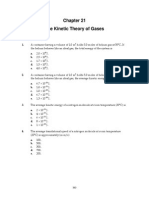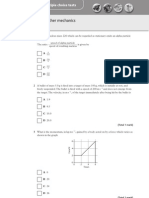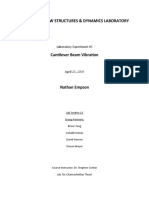Chapter 15 Electric Fields
Chapter 15 Electric Fields
Uploaded by
drewCopyright:
Available Formats
Chapter 15 Electric Fields
Chapter 15 Electric Fields
Uploaded by
drewOriginal Description:
Copyright
Available Formats
Share this document
Did you find this document useful?
Is this content inappropriate?
Copyright:
Available Formats
Chapter 15 Electric Fields
Chapter 15 Electric Fields
Uploaded by
drewCopyright:
Available Formats
Oscillatory Motion21
Chapter 15
Oscillatory Motion
Multiple Choice
1.
A body of mass 5.0 kg is suspended by a spring which stretches 10 cm when the
mass is attached. It is then displaced downward an additional 5.0 cm and
released. Its position as a function of time is approximately
a.
b.
c.
d.
e.
2.
y = .10 sin 9.9t
y = .10 cos 9.9t
y = .10 cos (9.9t + .1)
y = .10 sin (9.9t + 5)
y = .05 cos 9.9t
A body oscillates with simple harmonic motion along the x-axis. Its displacement
varies with time according to the equation x = 5.0 sin (t). The acceleration (in
2
m/s ) of the body at t = 1.0 s is approximately
a.
b.
c.
d.
e.
3.
3.5
49
14
43
4.3
A body oscillates with simple harmonic motion along the x axis. Its displacement
varies with time according to the equation x = 5 sin (t + /3). The phase (in rad)
of the motion at t = 2 s is
a.
b.
c.
d.
e.
7/3
/3
5/3
2
22CHAPTER 15
4.
A body oscillates with simple harmonic motion along the x axis. Its displacement
varies with time according to the equation x = 5.0 sin (t + /3). The velocity (in
m/s) of the body at t = 1.0 s is
a.
b.
c.
d.
e.
5.
The motion of a particle connected to a spring is described by x = 10 sin (t). At
what time (in s) is the potential energy equal to the kinetic energy?
a.
b.
c.
d.
e.
6.
0
0.25
0.50
0.79
1.0
The amplitude of a system moving with simple harmonic motion is doubled. The
total energy will then be
a.
b.
c.
d.
e.
7.
+8.0
8.0
14
+14
5.0
4 times larger
3 times larger
2 times larger
the same as it was
half as much
A mass m = 2.0 kg is attached to a spring having a force constant k = 290 N/m as
in the figure. The mass is displaced from its equilibrium position and released.
Its frequency of oscillation (in Hz) is approximately
a.
b.
c.
d.
e.
12
0.50
0.01
1.9
0.08
Oscillatory Motion23
8.
The mass in the figure slides on a frictionless surface. If m = 2 kg, k1 = 800 N/m
and k2 = 500 N/m, the frequency of oscillation (in Hz) is approximately
a.
b.
c.
d.
e.
9.
6
2
4
8
10
Two circus clowns (each having a mass of 50 kg) swing on two flying trapezes
(negligible mass, length 25 m) shown in the figure. At the peak of the swing, one
grabs the other, and the two swing back to one platform. The time for the
forward and return motion is
a.
b.
c.
d.
e.
10 s
50 s
15 s
20 s
25 s
24CHAPTER 15
10.
A uniform rod (mass m = 1.0 kg and length L = 2.0 m) pivoted at one end
oscillates in a vertical plane as shown below. The period of oscillation (in s) is
approximately
a.
b.
c.
d.
e.
11.
4.0
1.6
3.2
2.3
2.0
A horizontal plank (m = 2.0 kg, L = 1.0 m) is pivoted at one end. A spring
3
(k = 1.0 10 N/m) is attached at the other end, as shown in the figure. Find the
angular frequency (in rad/s) for small oscillations.
a.
b.
c.
d.
e.
39
44
55
66
25
Oscillatory Motion25
12.
The figure shows a uniform rod (length L = 1.0 m, mass = 2.0 kg) suspended from
a pivot a distance d = 0.25 m above its center of mass. The angular frequency (in
rad/s) for small oscillations is approximately
a.
b.
c.
d.
e.
13.
In the figure below, a disk (radius R = 1.0 m, mass = 2.0 kg) is suspended from a
pivot a distance d = 0.25 m above its center of mass. The angular frequency (in
rad/s) for small oscillations is approximately
a.
b.
c.
d.
e.
14.
1.0
2.5
1.5
4.1
3.5
4.2
2.1
1.5
1.0
3.8
In the figure below, a hoop (radius R = 1.0 m, mass = 2.0 kg) having four spokes
of negligible mass is suspended from a pivot a distance d = .25 m above its center
of mass. The angular frequency (in rad/s) for small oscillations is approximately
a.
b.
c.
d.
e.
4.0
2.5
1.5
1.0
0.5
26CHAPTER 15
15.
A torsional pendulum consists of a solid disk (mass = 2.0 kg, radius = 1.0 m)
suspended by a wire attached to a rigid support. The body oscillates about the
support wire. If the torsion constant is 16 N m. What is the angular frequency
(in rad/s)?
a.
b.
c.
d.
e.
16.
2
4
6
8
7
The mass in the figure below slides on a frictionless surface. When the mass is
pulled out, spring 1 is stretched a distance x1 from its equilibrium position and
spring 2 is stretched a distance x2. The spring constants are k1 and k2 respectively.
The force pulling back on the mass is:
a.
k2x1.
b.
k2x2.
c.
(k1x1 + k2x2).
d.
e.
k1 k 2
( x1 x 2 ) .
2
k1 k 2
( x1 x 2 ) .
k1k 2
Oscillatory Motion27
17.
A hoop, a solid cylinder, and a solid sphere all have the same mass m and the
same radius R. Each is mounted to oscillate about an axis a distance 0.5 R from
the center. The axis is perpendicular to the circular plane of the hoop and the
cylinder and to an equatorial plane of the sphere as shown below. Which is the
correct ranking in order of increasing angular frequency ?
a.
b.
c.
d.
e.
18.
hoop, cylinder, sphere
cylinder, sphere, hoop
sphere, cylinder, hoop
hoop, sphere, cylinder
sphere, hoop, cylinder
Three pendulums with strings of the same length and bobs of the same mass are
pulled out to angles 1, 2 and 3 respectively and released. The approximation
sin = holds for all three angles, with 3 > 2 > 1. How do the angular
frequencies of the three pendulums compare?
19.
a.
3 > 2 > 1
b.
c.
d.
Need to know amplitudes to answer this question.
Need to know g/L to answer this question.
1 > 2 > 3
e.
1 = 2 = 3
A weight of mass m is at rest at O when suspended from a spring, as shown.
When it is pulled down and released, it oscillates between positions A and B.
Which statement about the system consisting of the spring and the mass is
correct?
a.
b.
c.
d.
e.
The gravitational potential energy of the system is greatest at A.
The elastic potential energy of the system is greatest at O.
The rate of change of momentum has its greatest magnitude at A and B.
The rate of change of gravitational potential energy is smallest at O.
The rate of change of gravitational potential energy has its greatest
magnitude at A and B.
28CHAPTER 15
20.
An object of mass m is attached to string of length L. When it is released from
point A, the object oscillates between points A and B. Which statement about the
system consisting of the pendulum and the Earth is correct?
a.
b.
c.
d.
e.
21.
The gravitational potential energy of the system is greatest at A and B.
The kinetic energy of mass m is greatest at point O.
The greatest rate of change of momentum occurs at A and B.
All of the above are correct.
Only (a) and (b) above are correct.
A graph of position versus time for an object oscillating at the free end of a
horizontal spring is shown below. A point or points at which the object has
positive velocity and zero acceleration is(are)
a.
b.
c.
d.
e.
B
C
D
B or D
A or E
Oscillatory Motion29
22.
A graph of position versus time for an object oscillating at the free end of a
horizontal spring is shown below. The point at which the object has negative
velocity and zero acceleration is
a.
b.
c.
d.
e.
23.
A
B
C
D
E
A graph of position versus time for an object oscillating at the free end of a
horizontal spring is shown below. The point at which the object has zero velocity
and positive acceleration is
a.
b.
c.
d.
e.
A
B
C
D
E
30CHAPTER 15
24.
A graph of position versus time for an object oscillating at the free end of a
horizontal spring is shown below. The point at which the object has zero velocity
and negative acceleration is
a.
b.
c.
d.
e.
25.
In an inertia balance, a body supported against gravity executes simple harmonic
oscillations in a horizontal plane under the action of a set of springs. If a 1.00 kg
body vibrates at 1.00 Hz, a 2.00 kg body will vibrate at
a.
b.
c.
d.
e.
26.
A
B
C
D
E
0.500 Hz.
0.707 Hz.
1.00 Hz.
1.41 Hz.
2.00 Hz.
At sea level, at a latitude where g 9.80
m
, a pendulum that takes 2.00 s for a
s2
complete swing back and forth has a length of 0.993 m. What is the value of g in
m/s2 at a location where the length of such a pendulum is 0.970 m?
a.
b.
c.
d.
e.
0.0983
3.05
9.28
10.0
38.3
Oscillatory Motion31
Suppose it were possible to drill a frictionless cylindrical channel along a
diameter of the Earth from one side of the Earth to another. A body dropped into
such a channel will only feel the gravitational pull of mass within a sphere of
radius equal to the distance of the mass from the center of the Earth . The density
27.
2
kg
11 N m
of the Earth is 5.52 10 3 and G 6.67 10
. The mass will oscillate
kg 2
m
with a period of
a.
b.
c.
d.
e.
84.4 min.
169 min.
24.0 h.
1130 h.
27.2 d.
A 2.00 m-long 6.00 kg ladder pivoted at the top hangs down from a platform at
the circus. A 42.0 kg trapeze artist climbs to a point where her center of mass is at
the center of the ladder and swings at the systems natural frequency. The angular
frequency (in s1 ) of the system of ladder and woman is
28.
a.
b.
c.
d.
e.
1.01.
2.01.
4.03.
8.05.
16.2.
Ellen says that whenever the acceleration is directly proportional to the
displacement of an object from its equilibrium position, the motion of the object
is simple harmonic motion. Mary says this is true only if the acceleration is
opposite in direction to the displacement. Which one, if either, is correct?
29.
a.
b.
c.
d.
e.
Ellen, because 2 is directly proportional to the constant multiplying the
displacement and to the mass.
Ellen, because 2 is directly proportional to the mass.
Mary, , because 2 is directly proportional to the constant multiplying the
displacement
and to the mass.
Mary, because 2 is directly proportional to the mass.
because the second derivative of an oscillatory function like sin(t)
Mary,
cos(t) always is the negative of the original function.
or
32CHAPTER 15
30.
John says that the value of the function cos[ (t T) ] , obtained one period T
after time t, is greater than cos(t ) by 2 . Larry says that it is greater by
the addition of 1.00 to cos(t ) . Which one, if either, is correct?
a.
b.
c.
d.
e.
31.
Simple harmonic oscillations can be modeled by the projection of circular motion
angular velocity onto a diameter of the circle. When this is done, the
at constant
the diameter of the centripetal acceleration of the particle executing
analog along
circular motion is
a.
b.
c.
d.
e.
32.
John, because T 2 .
John, because
T 1radian .
Larry, because
.
T 2
Larry, because T 1radian .
Neither,
because cos( 2 ) cos .
the displacement from the center of the diameter of the projection of the
position of the particle on the circle.
the projection along the diameter of the velocity of the particle on the circle.
the projection along the diameter of tangential acceleration of the particle on
the circle.
the projection along the diameter of centripetal acceleration of the particle
on the circle.
meaningful only when the particle moving in the circle also has a non-zero
tangential acceleration.
When a damping force is applied to a simple harmonic oscillator which has
angular frequency 0 in the absence of damping, the new angular frequency
is such that
a.
.
0
b.
0 .
c.
.
0
d.
T T .
0 0
e.
T T .
0 0
Oscillatory Motion33
33.
34.
When a damping force is applied to a simple harmonic oscillator which has
period T0 in the absence of damping, the new period T is such that
a.
T T .
0
b.
T T .
0
c.
T T .
0
d.
T T .
0 0
e.
T T .
0 0
To double the total energy of a mass oscillating at the end of a spring with
amplitude A, we need to
a.
b.
c.
d.
e.
increase the angular frequency by 2 .
increase the amplitude by 2 .
increase the amplitude by 2.
increase the angular frequency
by 2.
increase the amplitude
by 4 and decrease the angular frequency by
.
2
Open-Ended Problems
35.
An automobile (m = 1.00 10 kg) is driven into a brick wall in a safety test. The
6
bumper behaves like a spring (k = 5.00 10 N/m), and is observed to compress a
distance of 3.16 cm as the car is brought to rest. What was the initial speed of the
automobile?
36.
The mat of a trampoline is held by 32 springs, each having a spring constant of
5000 N/m. A person with a mass of 40.0 kg jumps from a platform 1.93 m high
onto the trampoline. Determine the stretch of each of the springs.
37.
An archer pulls her bow string back 0.4 m by exerting a force that increases
uniformly from zero to 240 N. What is the equivalent spring constant of the bow,
and how much work is done in pulling the bow?
34CHAPTER 15
38.
An ore car of mass 4000 kg starts from rest and rolls downhill on tracks from a
mine. A spring with k = 400 000 N/m is located at the end of the tracks. At the
springs maximum compression, the car is at an elevation 10 m lower than its
elevation at the starting point. How much is the spring compressed in stopping
the ore car? Ignore friction.
39.
The motion of a piston in an auto engine is simple harmonic. If the piston travels
back and forth over a distance of 10 cm, and the piston has a mass of 1.5 kg, what
is the maximum speed of the piston and the maximum force acting on the piston
when the engine is running at 4200 rpm?
Oscillatory Motion35
36CHAPTER 15
Chapter 15
Oscillatory Motion
1.
21.
2.
22.
3.
23.
4.
24.
5.
25.
6.
26.
7.
27.
8.
28.
9.
29.
10.
30.
11.
31.
12.
32.
13.
33.
14.
34.
15.
35.
2.23 m/s (5 mph)
16.
36.
9.97 cm
17.
37.
600 N/m, 48 J
18.
38.
1.4 m
19.
39.
22 m/s, 14 500 N
20.
Oscillatory Motion37
You might also like
- HW1 Mastering PhysicsDocument16 pagesHW1 Mastering Physicszmontgom183% (6)
- Testbank Chapter15Document11 pagesTestbank Chapter15AnaMendezNo ratings yet
- PSE 9e CH 24 CH 25 26 Combined SerwayDocument60 pagesPSE 9e CH 24 CH 25 26 Combined SerwayYaas BahNo ratings yet
- TB Chapter21Document13 pagesTB Chapter21Muhammad Tayyab MadniNo ratings yet
- Wolfson Eup3 Ch15 Test BankDocument16 pagesWolfson Eup3 Ch15 Test Bankifghelpdesk100% (1)
- Mastering Physics - Mek2 - Assignment 1Document11 pagesMastering Physics - Mek2 - Assignment 1rexc483% (6)
- Wolfson Eup3 ch09 Test BankDocument15 pagesWolfson Eup3 ch09 Test Bank陳禹誌No ratings yet
- Wolfson Eup3 Ch33 Test BankDocument13 pagesWolfson Eup3 Ch33 Test BankifghelpdeskNo ratings yet
- Revision Checklist For O-Level Physics 5054: WWW - Revision-Notes - Co.ccDocument24 pagesRevision Checklist For O-Level Physics 5054: WWW - Revision-Notes - Co.ccLion Jude Tissera0% (1)
- Applications of Newtons Laws - Practice ProblemsDocument4 pagesApplications of Newtons Laws - Practice ProblemslisagolzarNo ratings yet
- Chapter - 8 - Simple Harmonic MotionDocument12 pagesChapter - 8 - Simple Harmonic MotionMohammed Aftab Ahmed0% (1)
- CH 23Document25 pagesCH 23Shadan9250% (2)
- Chapter 31Document22 pagesChapter 31OmarWaelNo ratings yet
- Free Access To University Physics With Modern Physics 14th Edition Young Solutions Manual Chapter AnswersDocument68 pagesFree Access To University Physics With Modern Physics 14th Edition Young Solutions Manual Chapter Answersmridulsiyala100% (2)
- Unit 1: MechanicsDocument51 pagesUnit 1: MechanicsMaria BhaijiNo ratings yet
- Matriculation Physics Magnetic FieldDocument112 pagesMatriculation Physics Magnetic FieldMaslinda Mat SharifNo ratings yet
- Phy A2 Teacher GuideDocument87 pagesPhy A2 Teacher GuidefaroofashNo ratings yet
- Worksheet 17Document2 pagesWorksheet 17Vijay BhaskarNo ratings yet
- University Physics with Modern Physics 14th Edition Young Test Bank PDF Download Full Book with All ChaptersDocument52 pagesUniversity Physics with Modern Physics 14th Edition Young Test Bank PDF Download Full Book with All Chaptersslogarvitkay100% (4)
- Chapter 23Document26 pagesChapter 23Carlos Arturo AlanizNo ratings yet
- VibDocument12 pagesVibChristelle DomingoNo ratings yet
- Chap6 PhysicsDocument23 pagesChap6 PhysicsMadhavi SivanNo ratings yet
- CH 29 Tutorials Problems - With SolutionsDocument5 pagesCH 29 Tutorials Problems - With Solutionsshihabsultan100% (1)
- Multiple Choice Questions For Physics 1Document55 pagesMultiple Choice Questions For Physics 1OsamaHeshamNo ratings yet
- Chapter 10-Rotation of A Rigid Object About A Fixed Axis: Multiple ChoiceDocument23 pagesChapter 10-Rotation of A Rigid Object About A Fixed Axis: Multiple ChoiceMerlin Trochez 504No ratings yet
- PHYSICS 101 Test Bank 2Document24 pagesPHYSICS 101 Test Bank 2Leenie Anne Ang-AngcoNo ratings yet
- Newton S Second Law 11 IB WorksheetDocument3 pagesNewton S Second Law 11 IB WorksheetYusuf Firas JarrarNo ratings yet
- Test Bank 7Document20 pagesTest Bank 7LukeLi100% (1)
- R2019 49P1MSDocument29 pagesR2019 49P1MSSkruzdelyte MielaNo ratings yet
- Simple Harmonic Motion and ElasticityDocument15 pagesSimple Harmonic Motion and ElasticitySubho BhattacharyaNo ratings yet
- Multiple-Choice Question 1985 Take G 10 m/s2.: Velocity/msDocument16 pagesMultiple-Choice Question 1985 Take G 10 m/s2.: Velocity/mssliversniperNo ratings yet
- 6185-Revision Test 1 Class XII Physics Dec 16Document5 pages6185-Revision Test 1 Class XII Physics Dec 16Rehan AhmadNo ratings yet
- 2015 PhySc GRD 12 Photoelectric Effect NotesDocument48 pages2015 PhySc GRD 12 Photoelectric Effect Notesdatboydion1No ratings yet
- Dynamics Multiple Choice QuestionsDocument8 pagesDynamics Multiple Choice QuestionsPaola Rafaela FacchineiNo ratings yet
- 212 - Problem Set 3Document2 pages212 - Problem Set 3everyoneMDNo ratings yet
- Chapter 6: Wave: 6.1 Understanding WavesDocument35 pagesChapter 6: Wave: 6.1 Understanding WavesZulhisyam NordinNo ratings yet
- 2.2 Forces ReviewDocument17 pages2.2 Forces ReviewAmrit sharmaNo ratings yet
- Wolfson Eup3 Ch14 Test BankDocument29 pagesWolfson Eup3 Ch14 Test Bankifghelpdesk100% (1)
- Simple Harmonic Motion Multiple Choice-2013!07!11Document5 pagesSimple Harmonic Motion Multiple Choice-2013!07!11Vishal NanwaniNo ratings yet
- Physics Project Class 12Document13 pagesPhysics Project Class 12vinayNo ratings yet
- 5 Work, Energy and PowerDocument39 pages5 Work, Energy and PowerGeanelle BonilloNo ratings yet
- Special Relativity RedactedDocument5 pagesSpecial Relativity RedactedShane TerealNo ratings yet
- A2 Physics Monthly Test January 2017Document3 pagesA2 Physics Monthly Test January 2017AbhiKhanNo ratings yet
- MasteringPhysics - CH 21 HW #6Document5 pagesMasteringPhysics - CH 21 HW #6Giancarlo Santos0% (1)
- Universal GravitationDocument15 pagesUniversal GravitationGia GavicaNo ratings yet
- Exercises Waves - IDocument12 pagesExercises Waves - ICarlos ValverdeNo ratings yet
- 02 Momentum & Energy Extra Study QuestionsDocument141 pages02 Momentum & Energy Extra Study QuestionsTheBigbrains Aceo50% (2)
- Wave Phenomena PracticeDocument63 pagesWave Phenomena PracticeDeepak SinghNo ratings yet
- Mass and Inertia: Dynamics 1Document11 pagesMass and Inertia: Dynamics 1Joe West100% (2)
- Physics Inter Part 1 (Sample/Guess Paper) For Exams in 2020Document3 pagesPhysics Inter Part 1 (Sample/Guess Paper) For Exams in 2020Aftab AhmadNo ratings yet
- Worksheet (AS) PDFDocument3 pagesWorksheet (AS) PDFMahad AsimNo ratings yet
- CH 24 HWDocument23 pagesCH 24 HWGiancarlo SantosNo ratings yet
- Simple Harmonic MotionDocument7 pagesSimple Harmonic MotionRaju SinghNo ratings yet
- Physics 1 Sample Multiple Choice ProblemsDocument4 pagesPhysics 1 Sample Multiple Choice ProblemsXinhua WangNo ratings yet
- LE2 ReviewDocument60 pagesLE2 ReviewaraneyaNo ratings yet
- Physics I Problems PDFDocument1 pagePhysics I Problems PDFBOSS BOSSNo ratings yet
- MotionDocument23 pagesMotionKimberley Anne SeeNo ratings yet
- Simple Harmonic MotionDocument7 pagesSimple Harmonic MotionRaju SinghNo ratings yet
- Chapter 7 Tacoma Narrows BridgeDocument18 pagesChapter 7 Tacoma Narrows BridgeFernando SmithNo ratings yet
- L16 17 Shell StructuresDocument128 pagesL16 17 Shell StructuresAnand Thomas100% (1)
- Admmodule Gp12kin Ic 23Document25 pagesAdmmodule Gp12kin Ic 23Diana Silva HernandezNo ratings yet
- Chapter 2Document54 pagesChapter 2Godwin Acquah100% (1)
- Engineering Science - Dynamic Engineering SystemsDocument13 pagesEngineering Science - Dynamic Engineering SystemsSteven Goddard100% (1)
- Working Stresses For Visually Stress-Graded Unseasoned Structural Timber of Philippine WoodsDocument4 pagesWorking Stresses For Visually Stress-Graded Unseasoned Structural Timber of Philippine WoodsAeron LamsenNo ratings yet
- Ley de GaussDocument7 pagesLey de GaussJoynny bNo ratings yet
- Evolution of The Electric Power Components Definitions: Adrian A. Adăscăliţei, Alexander E. EmanuelDocument6 pagesEvolution of The Electric Power Components Definitions: Adrian A. Adăscăliţei, Alexander E. EmanuelhanifNo ratings yet
- Design of Beams Using First PrincipleDocument128 pagesDesign of Beams Using First PrincipleMohamed GledanNo ratings yet
- Design of Continuous Beam - LatestDocument10 pagesDesign of Continuous Beam - LatestMegatAridzNo ratings yet
- Some Examples. Constraints and Lagrange MultipliersDocument15 pagesSome Examples. Constraints and Lagrange MultipliersGuillermoEatonNo ratings yet
- ASME ImpDocument6 pagesASME ImpMarc AnmellaNo ratings yet
- HydraulicsDocument3 pagesHydraulicsLa Niña Sta InesNo ratings yet
- Guide For Power PredictionDocument11 pagesGuide For Power PredictionpagliasoNo ratings yet
- Reinforced Concrete Beam Test in LabDocument11 pagesReinforced Concrete Beam Test in Labsalmanfarshi58No ratings yet
- Pipe Is Under Clamping ForceDocument7 pagesPipe Is Under Clamping Forcejosediaz141No ratings yet
- Rotor Dynamics 1Document14 pagesRotor Dynamics 1Marco NeveNo ratings yet
- Water Hydraulics Control Technology by Trostmann, ErikDocument193 pagesWater Hydraulics Control Technology by Trostmann, ErikYoel JenezNo ratings yet
- Aerospace 305W Structures & Dynamics LaboratoryDocument17 pagesAerospace 305W Structures & Dynamics Laboratorynke5001No ratings yet
- SSB05 Detailed Design of TrussesDocument131 pagesSSB05 Detailed Design of TrussesElton Maro100% (1)
- L-14 Fluids - 3: Fluids at Rest Fluids in MotionDocument19 pagesL-14 Fluids - 3: Fluids at Rest Fluids in Motionhamza A.laftaNo ratings yet
- Mech 343 Lab 2 ReportDocument16 pagesMech 343 Lab 2 ReportYousef MeguidNo ratings yet
- Draw The Cam Profile For Following ConditionsDocument3 pagesDraw The Cam Profile For Following ConditionsmaloyNo ratings yet
- P Q y T X T P y Q X y T: Visit Us At: WWW - Nodia.co - inDocument2 pagesP Q y T X T P y Q X y T: Visit Us At: WWW - Nodia.co - inSameerChauhanNo ratings yet
- Statistical Description of Two Level SystemsDocument53 pagesStatistical Description of Two Level SystemsJeet BhattacharjeeNo ratings yet
- Ampere's Circuital LawDocument8 pagesAmpere's Circuital LawaliNo ratings yet
- 01 - Pile-soiPile-soil Interaction Via Abaqusl Interaction Via AbaqusDocument11 pages01 - Pile-soiPile-soil Interaction Via Abaqusl Interaction Via AbaqusJohn EloiNo ratings yet
- Calculations For Springs and DampersDocument3 pagesCalculations For Springs and DampersDheeraj SirimallaNo ratings yet
- Nu Rick 1976Document7 pagesNu Rick 1976XinDa ZhuNo ratings yet

























































































